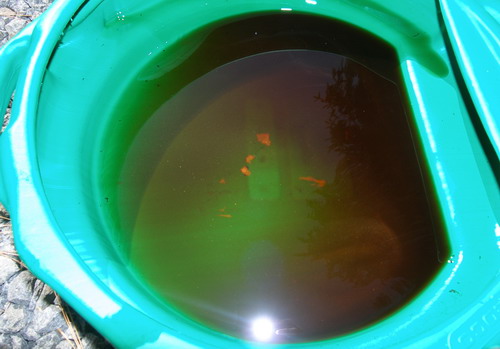October 8, 2006
Differential Fluid Replaced
 This
morning I decided to make another attempt to remove the differential fluid
plugs. I went to Eppy's yesterday with the hope of finding a 3/8" drive
16" breaker bar but it turned out the 16" model was available in
1/2" drive only.
The largest throw 3/8" drive model I could find was 10". I bought
both with an adapter for the 16" bar, but I knew very well clearance might
be an issue. Sure enough, once under the vehicle I tried the 16" bar
with the adapter and found the assembly about 3/4" of
an inch too deep. I then reached for the smaller 3/8" breaker bar and
found that fit perfectly. A few good tugs managed to break the drain plugs
free. Finally...I was in business.
This
morning I decided to make another attempt to remove the differential fluid
plugs. I went to Eppy's yesterday with the hope of finding a 3/8" drive
16" breaker bar but it turned out the 16" model was available in
1/2" drive only.
The largest throw 3/8" drive model I could find was 10". I bought
both with an adapter for the 16" bar, but I knew very well clearance might
be an issue. Sure enough, once under the vehicle I tried the 16" bar
with the adapter and found the assembly about 3/4" of
an inch too deep. I then reached for the smaller 3/8" breaker bar and
found that fit perfectly. A few good tugs managed to break the drain plugs
free. Finally...I was in business.
Since I didn't take the car out to warm it up, the gear oil seemed to take its sweet time finding its way into my drain pan, but in only a few minutes it slowed to a trickle. At first glance the fluid looked brand new and I questioned whether I really needed to drain the fluid. However, as I pulled the drain pan out from under the car and into direct sunlight, I was shocked to find it filled with a very fine mix of copper or brass-colored metallic particles. When stirred, the oil shimmered with a pearlescent quality that reminded me of (as odd as this sounds) a shampoo I once used. Dark amber in color, the fluid was also darker than I originally thought, and certainly dirtier than the new Mobil 1 75W-90 I pumped in. The differential took every bit of the 1.8 quarts as specified in the Bentley manual, but I certainly didn't remove that much. I'm not sure where the oil went, but it wasn't in the differential. If you look closely at the picture, you can see the "waves" of metallic particles in the lower right hand portion of the drain pan. Note that the orange flakes in the center of the pan are NOT pieces of my differential...they're simply paper and glue residue leftover from the drain pan marketing label (thankfully!)
With the differential topped off, I hand tightened the fill plug and then prepared to torque the plugs to 52 ft*lbs as specified in the Bentley. I approached the full torque carefully, but decided to stop short of the full spec because it just didn't feel right -- the bolt did not produce the expected resistance as it neared the specified torque value. This was probably due to the crush washer (the bolt continues to spin at a near constant torque value as the washer is compressed), but I didn't want to take any chances. If I stripped the threads, I'd have to replace the differential cover, and although I wouldn't mind replacing it with a nice new BMW finned cover similar to the one on my E46 I'd just as soon avoid the expense right now. To remedy the problem, I backed off to 35 ft*lbs and the torque wrench responded with a click. I then stepped it up to 40 ft*lbs and got another click. Trying 45 ft*lb, however, caused more rotation than I felt comfortable with, so I left it at that. Taking static friction into account, my guess is that the plugs are somewhere around 40 ft*lbs and frankly I think that's sufficient -- spec or no spec. After all, it's not like I'm preparing the differential for space flight, right?
I used a paper towel to clean the area around each plug and took the car out for a short drive to a local sandwich shop to test for leaks. None to report, so that's mission accomplished. A differential fluid flush at my dealer is roughly $150 ($50 in parts, the remainder in labor). The aftermarket gear oil cost me $16 and the parts department gave me the crush washers on the house, so I saved myself roughly $135 doing this job myself. Was it worth doing and getting dirty doing it? Survey says "yes".
If you're wondering if you should replace your differential fluid, this is my take. Modern (post 1996) non-M BMWs come with an open differential. Fluid in open differentials in does not need to be replaced as often as in limited slip differentials, but I think it should be replaced at the first inspection to rid the unit of the metal created during break-in, and then every 36000 miles (every Inspection II) to replenish the anti-wear properties of the oil and rid the unit of any wear metals that may have accumulated. The gear oil I removed was, of course, thicker than the average motor oil at room temperature, but was much thinner than the new gear oil, so it's safe to say that gear oil breaks down over time as all oils do. Don't believe BMW's hype of lifetime fill differential oil. Regularly change your fluid and preserve the like-new tolerances of your differential.
Mileage: 133740, Parts: $16, Tools and Equipment: $66. Labor Saved: $135



